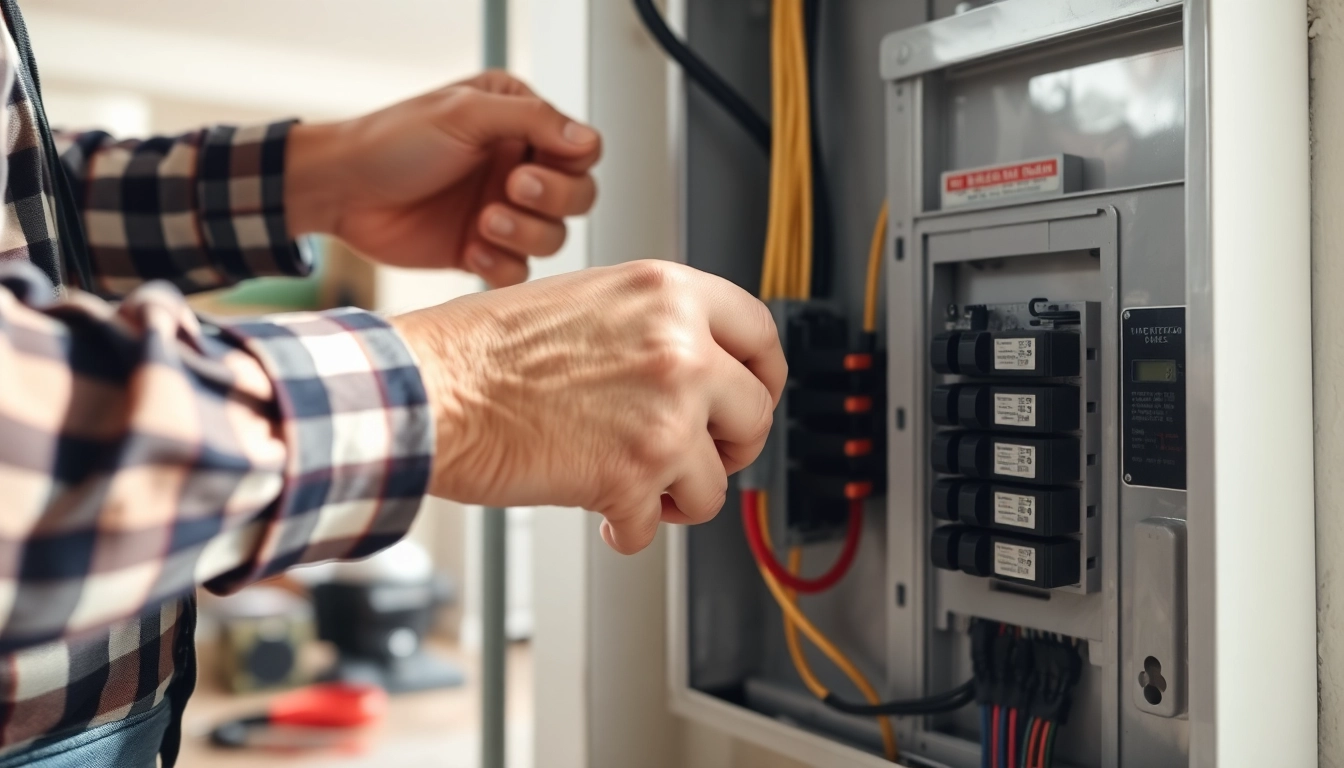Understanding Electrical Panel Upgrades
An electrical panel upgrade is a crucial home improvement that many homeowners may overlook until it’s too late. As our homes become increasingly reliant on electrical devices, ensuring that our electrical systems can handle this demand becomes essential. Upgrading your electrical panel not only enhances safety but also accommodates your evolving power needs. Understanding the factors involved in an Electrical Panel Upgrade will help you make informed decisions about your home’s energy management.
What is an Electrical Panel Upgrade?
At its core, an electrical panel upgrade involves replacing or augmenting the existing electrical panel in your home to improve its capacity to handle electrical loads. The electrical panel, often referred to as the breaker box, distributes electricity throughout your home. Upgrades are usually necessary when you want to increase the amperage of the service, change outdated components, or convert to more advanced technologies, such as solar panel systems or electric vehicle chargers.
Signs You Need to Upgrade Your Electrical Panel
- Frequent Circuit Breaker Trips: If your circuits frequently trip, it indicates that your current panel is overwhelmed.
- Enhancements to Home Electronics: Adding major appliances or devices, like HVAC systems or EV chargers, can exceed your panel’s capacity.
- Old Wiring Equipment: If you have an older panel (like 60 amps), it’s likely insufficient for modern demands.
- Burning Smell or Burn Marks: Discoloration or the smell of burning plastic around the panel is a serious sign of overheating and potential fire hazards.
- Home Renovations: Major upgrades or extensions to your home might necessitate an increase in your electrical system’s capacity.
Benefits of Upgrading Your Electrical Panel
Investing in an electrical panel upgrade can provide numerous advantages:
- Increased Safety: Newer panels come with updated safety features that can prevent electrical fires and reduce the risk of electric shock.
- Enhanced Electricity Supply: Higher amperage ratings facilitate greater electrical consumption, allowing you to run multiple appliances simultaneously without issues.
- Improved Efficiency: An upgraded electrical panel can enhance the efficiency of your home’s electrical system, potentially saving you money on energy bills.
- Increased Home Value: Homes with updated electrical systems can attract buyers more easily, which can maximize resale potential.
- Future-Proofing Your Home: Investing in a higher capacity panel prepares your home for future technology advancements and expansions.
Choosing the Right Electrical Panel for Your Home
Factors to Consider When Selecting an Electrical Panel
Choosing the right electrical panel is crucial for ensuring reliable and safe electricity supply. Consider the following factors:
- Amperage Rating: Panels commonly range from 100 to 200 amps. Determine your household usage and select a rating that fits your needs now and in the future.
- Type of Panel: Main panels, subpanels, or smart panels offer different functionalities. Assess which type best suits your needs.
- Brand Reputation: Select reliable brands with a good track record for safety and efficiency. Research customer reviews and ratings before making a choice.
- Space Availability: Ensure there is enough space in your home’s designated electrical area to accommodate the new panel.
- Local Codes: Be familiar with local building codes and standards to ensure that your chosen panel is compliant.
Understanding Electrical Panel Amperage Ratings
The amperage rating indicates how much current an electrical panel can handle. Here’s a breakdown of common ratings:
- 60 Amps: Older homes typically have this rating but are inadequate for modern needs.
- 100 Amps: Common in many homes, but might be insufficient with today’s higher energy demands.
- 200 Amps: Ideal for larger homes or those with significant electrical needs, including multiple appliances and modern technologies.
- 400 Amps and Above: Typically found in commercial spaces or very large residential homes requiring heavy-duty electrical load management.
Common Types of Electrical Panels
Understanding the different types of panels available will assist you in selecting the best fit for your home:
- Main Breaker Panels: These central systems distribute electricity throughout your home and are essential for setting the overall capacity.
- Subpanels: Used in larger homes to manage electrical distribution in remote areas or separate floors.
- Smart Panels: Incorporate technology that allows for monitoring energy usage, offering insights and control through connected devices.
- Load Centers: These can provide specialized circuit breakers for specific appliances, improving efficiency and safety.
The Process of Upgrading an Electrical Panel
Steps to Plan for an Upgrade
Planning an electrical panel upgrade requires careful considerations:
- Assessment: Evaluate your current electrical system’s capacity, looking for signs that an upgrade is needed.
- Determine Needs: List the total electrical load of the devices and appliances you intend to run, including future expansions.
- Consult a Professional: Engage a licensed electrician for an assessment and guidance tailored to your specific needs.
- Choose Your Panel: Based on assessed needs, choose the panel type and amp rating that suits your household requirements.
- Obtain Permits: Ensure you have the necessary permits obtained before starting the upgrade process.
Hiring Professionals vs. DIY Approaches
When it comes to electrical work, safety must come first. Though DIY upgrades may seem cost-effective, they can pose serious risks without the right expertise:
- Pros: DIY can save on labor costs, especially if you are skilled in electrical work.
- Cons: Minor mistakes can lead to major hazards, including electrical fires. Professional electricians ensure compliance with all safety codes.
In general, hiring certified professionals is advisable to mitigate risks and ensure a seamless upgrade process.
Permitting and Safety Regulations
Most regions require permits for electrical work to ensure safety and compliance with local codes. Here are essential steps to consider:
- Check Local Codes: Research the regulations in your area to determine required permits for an electrical panel upgrade.
- Work with Certified Electricians: Professional electricians are familiar with local codes and can help navigate the permitting process.
- Scheduling Inspections: Post-installation inspections are often mandatory to verify the upgrade complies with safety standards.
Cost Analysis of Electrical Panel Upgrades
Average Costs and Budgeting for an Upgrade
Understanding the financial investment required for an electrical panel upgrade is vital:
- Basic upgrades typically range from $800 to $4,000, depending on the panel’s amperage and local labor costs.
- The average upgrade from 100 to 200 amps usually costs between $1,300 and $3,000.
- Additional factors, such as upgrading wiring, installing new circuits, or adding surge protection, can affect overall expenses.
Potential Financial Benefits of Upgrading
Despite the initial investment, upgrading your electrical panel can provide long-term financial rewards:
- Increased Home Value: An upgraded panel enhances a home’s marketability, providing higher resale value when selling.
- Energy Efficiency: New panels can help manage energy consumption effectively, leading to lower utility bills.
- Insurance Benefits: Some insurance companies offer discounts to homeowners with updated electrical systems, as they pose less risk.
Exploring Financial Assistance and Tax Credits
Numerous financial assistance programs and tax credits exist for electrical panel upgrades, including:
- Local Utility Rebates: Some utility companies offer rebates for upgrading your panels to support energy-efficient appliances.
- Federal Tax Credits: Depending on upgrades performed, homeowners may qualify for tax credits that offset the costs associated with changes.
- State Incentives: Various states provide programs that subsidize home energy improvements, making it more affordable.
Maintaining Your Electrical System Post-Upgrade
Routine Maintenance Tips for Electrical Panels
After upgrading your electrical panel, implementing a maintenance routine is crucial for safety and performance:
- Regular Inspections: Have a professional electrician inspect the panel and wiring every few years to ensure everything is functioning properly.
- Check for Rust or Corrosion: Inspect for any signs of moisture or corrosion around the panel that could indicate problems.
- Keep It Clear: Ensure that the area around the panel is free from clutter, allowing for good airflow.
Signs of Electrical Issues After an Upgrade
Awareness of potential electrical issues post-upgrade can help you avoid dangerous situations:
- Strange Noises: Buzzing or crackling sounds from the panel could indicate loose connections.
- Warmth or Heat: If the panel feels unusually warm, it may be overloaded, warranting immediate professional attention.
- Frequent Blown Fuses: If circuits continue to blow after an upgrade, you may still have a wiring issue that needs addressing.
When to Call an Electrician for Help
If you experience any electrical issues or irregularities after your upgrade, do not hesitate to contact a licensed electrician:
- Major Changes in Load: If you add significant new devices or appliances, consult an electrician to assess the system’s capacity.
- Electrical Code Compliance: Any major changes should align with electrical codes; professional consultation can ensure compliance.
- Signs of Damage: If there are visible signs of damage or malfunction, immediate action is required to prevent fires or electrical hazards.



